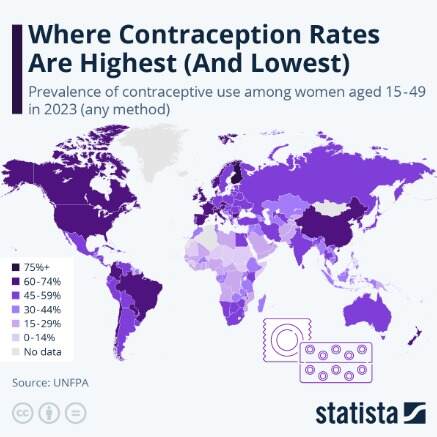“Contraception is not just about preventing pregnancies; it’s about empowering individuals to take control of their reproductive health and make choices that align with their life goals and aspirations.’’
Contraception
Contraception, also known as birth control, refers to methods and devices used to prevent pregnancy. There are various types of contraception available, ranging from hormonal methods like birth control pills and patches to barrier methods such as condoms and diaphragms.
Additionally, long-acting reversible contraceptives (LARCs) like intrauterine devices (IUDs) and implants offer highly effective options for preventing pregnancy with minimal user intervention are also covered under this.
Situation In Canada
In a recent turn of events, Canada has made contraception free for its citizens. Under the purview of a major healthcare reform, the government of Canada has undertaken an extremely progressive decision to incur the full cost of contraceptive methods for women.
The government will pay for the most widely used methods to avoid pregnancy, such as IUDs, contraceptive pills, hormonal implants, or the day-after pill, for the nine million Canadian women of reproductive age, Deputy Prime Minister Chrystia Freeland said at a press conference in a pharmacy in Toronto.
Prime Minister Justin Trudeau also enunciated and acknowledged the presence of financial barriers that women face while choosing to opt for contraceptives on X, formerly known as Twitter. Recently, Canada has recognized the need for a more widespread healthcare system inside the country and introduced a much-needed bill to expand its publicly funded healthcare system.
The government of Canada is on its way to bringing about more such healthcare reforms as a part of its new comprehensive public healthcare program. With almost 73 percent of women in Canada, aged between 15-49 being on birth control, such a step by the government was much called for.
Across the world

According to the World Health Organization (WHO), approximately 64% of women of reproductive age who are married or in a union use some form of contraception globally. Contraceptive usage rates vary by region. In developed countries, contraceptive prevalence tends to be higher compared to developing regions.
For example, in North America and Europe, contraceptive prevalence is around 73% and 69%, respectively, while in Sub-Saharan Africa, it is approximately 33%. The main reason for this enormous gap is the lack of resources and education available to women in these countries.
However, North America has the highest rate of effective usage of contraception which is almost 69.3%. The government in the USA is comparatively more vigilant in this area. Various policies like The Affordable Care Act (ACA), and most private health insurance plans cover contraceptive methods and counselling free of cost without any cost sharing with the patients.
The situation in India
The situation of Indian women concerning contraception has comparatively deteriorated because of the lack of awareness and the presence of a social stigma among women regarding its usage. This, along with additional costs of obtaining and spreading awareness regarding contraceptives, forms the major barrier barring women of India from leaning towards contraceptives to prevent pregnancy.
Additionally, women in India, especially in rural areas are oppressed to the point that they are mostly seen as baby-making machines.
In a recently conducted study, Female sterilization has emerged as the number one method of contraception used in India, accounting for about 76% of all use among women. However, The government has intervened in the situation with efforts trying to reverse the latter. It has unveiled various policies and initiatives that encourage couples to reroute towards better family planning and empower women to take control of their reproductive health in their own hands.
The Indian Legal System
Under initiatives like- The Family Planning Policy, the government has encouraged couples to adopt the usage of contraceptives, as it is much called for in an overpopulated country like India. Contraceptives are free in all Sub-centers, Primary Health Centers (PHCs), Community Health centers (CHCs) Rural Family Welfare Centers, District Hospitals, etc.
History of contraception in India
Following India’s independence in 1947, the government recognized the importance of family planning to address population growth and improve public health. In the 1950s and 1960s, the government launched family planning programs aimed at promoting contraceptive use and reducing fertility rates. These programs initially focused on sterilization methods, particularly female sterilization (tubectomy).
The introduction of Western medicine during the colonial era brought new contraceptive methods to India. However, early efforts to promote contraception were often met with resistance due to cultural taboos and religious beliefs. The dissemination of information about contraception was limited, and access to modern contraceptives was restricted.
Despite that, over the decades, India has expanded its contraceptive services to include a wide range of methods such as condoms, birth control pills, injectables, intrauterine devices (IUDs), and implants. Government-funded family planning clinics and outreach initiatives provide access to contraceptives, reproductive health education, and counseling services across the country.
Conclusion
In conclusion, this remarkable step by the government of Canada is a stepping stone towards a more empowering and equitable state where health-related resources are essentially more accessible to the whole population. By eliminating financial barriers to contraception, the government has encouraged the youth to take charge of their reproductive and sexual health and be more responsible regarding the latter. Other countries should also follow in their footsteps.
-ANANYA GUPTA
MUST READ: WILL THE CONFLICT BETWEEN IRAN AND ISRAEL GIVE RISE TO WORLD WAR 3?





